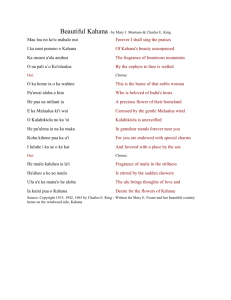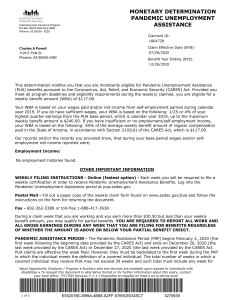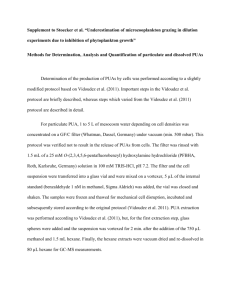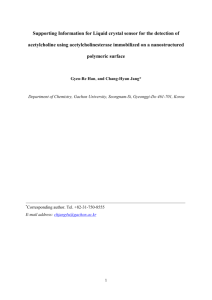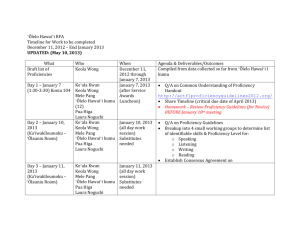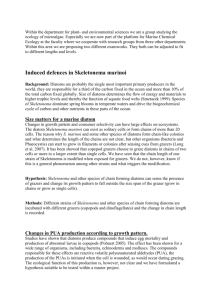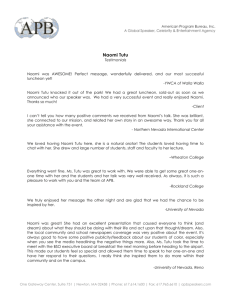Six - My eCoach
advertisement
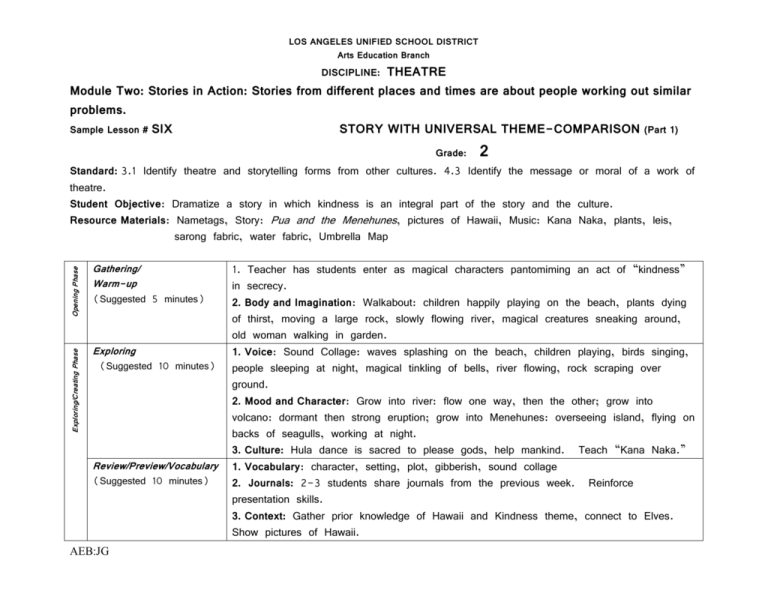
LOS ANGELES UNIFIED SCHOOL DISTRICT Arts Education Branch THEATRE Module Two: Stories in Action: Stories from different places and times are about people working out similar problems. Sample Lesson # SIX STORY WITH UNIVERSAL THEME-COMPARISON (Part 1) DISCIPLINE: Grade: 2 Exploring/Creating Phase Opening Phase Standard: 3.1 Identify theatre and storytelling forms from other cultures. 4.3 Identify the message or moral of a work of theatre. Student Objective: Dramatize a story in which kindness is an integral part of the story and the culture. Resource Materials: Nametags, Story: Pua and the Menehunes, pictures of Hawaii, Music: Kana Naka, plants, leis, sarong fabric, water fabric, Umbrella Map Gathering/ Warm-up (Suggested 5 minutes) Exploring (Suggested 10 minutes) Review/Preview/Vocabulary (Suggested 10 minutes) AEB:JG 1. Teacher has students enter as magical characters pantomiming an act of “kindness” in secrecy. 2. Body and Imagination: Walkabout: children happily playing on the beach, plants dying of thirst, moving a large rock, slowly flowing river, magical creatures sneaking around, old woman walking in garden. 1. Voice: Sound Collage: waves splashing on the beach, children playing, birds singing, people sleeping at night, magical tinkling of bells, river flowing, rock scraping over ground. 2. Mood and Character: Grow into river: flow one way, then the other; grow into volcano: dormant then strong eruption; grow into Menehunes: overseeing island, flying on backs of seagulls, working at night. 3. Culture: Hula dance is sacred to please gods, help mankind. Teach “Kana Naka.” 1. Vocabulary: character, setting, plot, gibberish, sound collage 2. Journals: 2-3 students share journals from the previous week. Reinforce presentation skills. 3. Context: Gather prior knowledge of Hawaii and Kindness theme, connect to Elves. Show pictures of Hawaii. Improvising/ Inventing Story Sharing/Reflect ing Phase (Suggested 20 minutes) Playmaking (Suggested 0 minutes) Reflecting/Journal prompt (Suggested 5 minutes) 1. Storytell Pua and the Menehunes up until Menehunes decide to help Pua; solicit students for ideas of how to help Grandma Tutu. Read ending of story. 2. Identify: Characters: Pua, Tutu, Waterboy, Menehunes, Friends; Setting: house, garden, beach, mountain, river, rocks, cave 3. Gibberish Improvisation: In groups of 3 or 4, students become Menehunes deciding how to help Pua and Tutu; they speak in gibberish. This will be done in the next lesson. 1. Discuss: How is this story similar to the Elves and the Shoemaker? 2. Journal: Create a flow map, character list and setting description for the story. Connections/Extensions: Identify the themes, characters and settings in other pieces of literature. Teacher Task: Compile a Flow Map of the plot, character list, and setting description from the students’ journals. AEB:JG PUA AND THE MENEHUNES Adapted by Vera Bachman Frazier from an old Hawaiian legend Every country has its legendary little people who surprise deserving human beings. Menehunes are the elf-like people of Hawaii. They are said to be friendly, obedient, industrious folk, about three feet in height. They are merry and strong, with bandy legs, short arms, and sturdy bodies. They do their secret deeds only at night so no one will see them. Any task they set out to do must be finished before dawn. If this cannot be done they never return to that work, for it is part of their ritual which they always honor. This fantasy reveals the golden rule theme in a fresh version through the appealing characters of Pua, Tutu, the Menehunes, and children playing on the beach. Original thinking has been encouraged by Pua’s songs, dances, beach play, and by the singing stream. Pua was happy. She lived with Tutu, her kind, old grandmother on the slopes of Haleakala on a beautiful island in a blue ocean. Pua had been named for a flower. She was cheerful and graceful like a bright Hawaiian flower when it dances gently with a breeze. Every summer morning after Pua finished with the morning work she made Tutu comfortable under the shade of a big banyan tree. Then down the hillside Pua would run to the beach to play with her friends. The children were always happy when Pua joined them for Pua thought of new water games and new dances on the sands. Often she showed her friends how to make presents from flowers and stones and surprises they found on the beach. Every day Pua took a surprise from the beach to Tutu. One afternoon when Pua came up from playing she saw that her grandmother was deeply troubled. “Tutu, why have your smiles gone away? The sun shines yet you are quiet like a dark cloud. What is it that troubles you?” “Oh, my little Pua. I see I cannot keep my thoughts from you. It is the taro patch. Look, the sun burns down upon it. The water boy comes no more. I am too old to carry water. I fear my taro fields will soon wilt and die.” “So that is it,” said Pua cheerfully, for she was somewhat relieved. “Never fear, Tutu. I can carry water. I will go now and give the taro a fresh drink of water.” “Oh, my little one, the patch is so big. You are so small.” Tutu shook her head for she knew it was too great a task for little Pua. “Watch and you will see what I do,” Pua said as she found wooden pails behind the hut and hurried to the mountain stream which ran down behind the house away from the taro patch. Pua sang as she worked. Her friends called to her from the beach, but Pua told them she would be carrying water all the rest of the day. Tutu sat patiently and watched. She worried about the taro and she worried even more about Pua, for her frail little body bent almost double under the weight of the wooden pails. Pua was happy while she worked. She was so busy carrying water that she did not know that anyone was near. Neither did Tutu. AEB:JG But the Menehunes watched closely. They hid in their secret hiding places in holes under the rocks and under big, brown roots. Each Menehune watched to see Pua, but he was careful not to be seen. Each gave a secret sign to the leader to show that he thought they should help Pua. At last Tutu went inside the hut and called Pua to have supper. Soon it grew dark. When everything was quiet, the Menehune leader danced out of his hiding place. He called to the others. Each one came quietly. He followed the leader in a big dance around the taro patch. The Menehunes circled together to make a plan as Menehunes do when they are up to their magic. When their secret was planned each hurried to the top of the mountain where the stream was flowing. Together they tugged and pushed and pulled on stones which were as big as they were. They tugged and lifted and carried the stones to change the path of the stream. They worked all through the night. Just as the first birds chirped a good morning, the Menehunes finished their secret task. The mountain stream rolled down the hill right near the taro patch. While it bubbled along, the water ran out onto the taro field. The stream said, “Pau, pau Pilikia, Pau, pau, Pilikia.” The Menehunes danced and sang with joy in their secret ceremony. Then they hurried to hide in their secret places. Inside the hut, Pua heard the birds singing. She wondered at once about the taro patch. She hurried outside to see if it were wilted from the warm night. Pua couldn’t believe what she saw. The taro was green and fresh. Pua ran to the field. She saw the mountain stream running by. She called to Tutu as she ran back to the hut, but Tutu was watching in the doorway. “Tutu, it is like a dream! How could the stream change its place for running?” Tutu was surprised too. “I do not understand it,” said the old grandmother. “In all my life I have never seen anything happen like this. The only thing I can think of is the Menehunes, but no one has ever seen one of these little folk, only heard of them.” Tutu smiled and shook her head. “Menehunes!” said Pua. “The children on the beach say the Menehunes only help those who deserve it and we haven’t done anything like that, Tutu.” She ran out to the green taro and looked again and listened to the singing stream. Pua turned and called aloud, “Thank you, whoever you are! Thank you from Tutu and me and the taro. You’ve made us happy.” Down in their secret hiding places the Menehunes heard and they were the happiest of all with their secret. AEB:JG KANA NAKA A Traditional Dance from Hawaii TO BEGIN: Have everyone sit or kneel down all facing the same direction. Space everyone out so that there is plenty of room to move arms to both sides and to the front. SEQUENCE 1: LET ME TELL YOU A STORY: Begin with both hands on hips. Bring both arms forward (palms down) and cross them slightly. Turn palms up and spread arms apart (as if presenting to each side). ABOUT UNDER THE OCEAN: Raise arms straight up over your head and cross them slightly (palms forward). Curve hands down while bringing both arms forward and down (as if diving into the ocean). IN THE SEA GRASSES: Bring both arms straight up from the shoulders (arms are relaxed) and move them to the right and left with the hands following slightly behind the arms (wrist loose as if to imitate seaweed in the ocean). LIVES KANA NAKA: With hands still above shoulders, outline a person or an hourglass moving the arms and hands downwards until hands are at about shoulder height. SHE IS LOOKING FOR HER PRINCE: Place fingertips of 1st and 2nd fingers at each temple with the arms bent and elbows to the sides (as if to share your eyes). WHO IS FAR AWAY: Reach both hands forward outstretched as far as possible at about shoulder level. SHE IS REACHING OUT TO HER PRINCE: Bring right arm straight back with the elbow bending until the right hand is next to the right hip. At the same time extend the left hand further forward by twisting slightly at the waist and moving the left shoulder forward. Then reverse by bringing the left arm back bending at the elbow to the left hip while extending the right arm straight out and moving the right shoulder forward. Bring both arms back to hang at sides. SO SHE CAN BUILD HIM A HOUSE: In a circular motion move hands to the sides and then around to the front (about chest level) and make a triangle with both hands (with only the thumbs, 1st and 2nd fingers touching). UNDER THE SEA: Hands make backward (top hand moves towards the body) circular motion at about chest level. Bottom hand moves as if you were digging up sand with the back of your hand (scooping forward as you dig). SO SHE CAN BULD HIM A HOUSE (VARIATION): Make a triangle (as before) but place it by your right hip and move it upwards and across you body to the left until it is level with your head. AEB:JG UNDER THE SEA (VARIATION): Same movement as before but begin with your hands at the finishing point of the last movement and slowly bring them back to the center of your chest as you circle the hands slowly backward. REPEAT SEQUENCE 1. SEQUENCE 2: ALOHA: Right hand is in front of mouth with arm bent, elbow at shoulder level. Left arm is out to the side and slightly behind the left shoulder (arm relaxed and sloping gently upwards). Right hand moves slowly across the mouth from left to right as you slowly twist the body to the right dragging the left should and arm forward slightly. Hands move as if to roll a pencil between the thumb and 2 nd finger (make this motion twice with both hands). Reverse hands so that left hand is in front of mouth and right arm is out to the side and slightly behind the right shoulder. Repeat previous movement on other side. REPEAT SEQUENCE 1 FROM IN THE SEA GRASSES TO END. REPEAT SEQUENCE 2. ENDING: THE WAVES GO OUT AND THE WAVES COME IN: Place both hands in front level with your solar plexus (palms down). Move both hands to the sides slowly while moving arms up and down very gently (as if tracing the surface of a calm sea) while the hands move the same as in the aloha movement. Then move both hands back together slowly (still moving gently up and down) until the hands meet and gently rest one hand on top of the other to finish. COUNTRY OF ORIGIN: Hawaii NOTES: The hula was originally done as a means of story telling to preserve the history of the Polynesian tribes. Before the arrival of the Europeans, Polynesians had no written language for this purpose. Also, until the arrival of the Europeans only the men were allowed to perform the dances. VARIATIONS: At the beginning have only the girls kneel, with the boys standing directly behind them. Copyright 1996. These notes are the exclusive property of the Gypsy Folk Ensemble. Any reproduction without the express permission of the Gypsy Folk Ensemble is strictly prohibited. Judi Garratt has been given permission to use these notes in combination with teaching the story, Pua and the Menehunes to schools. AEB:JG
